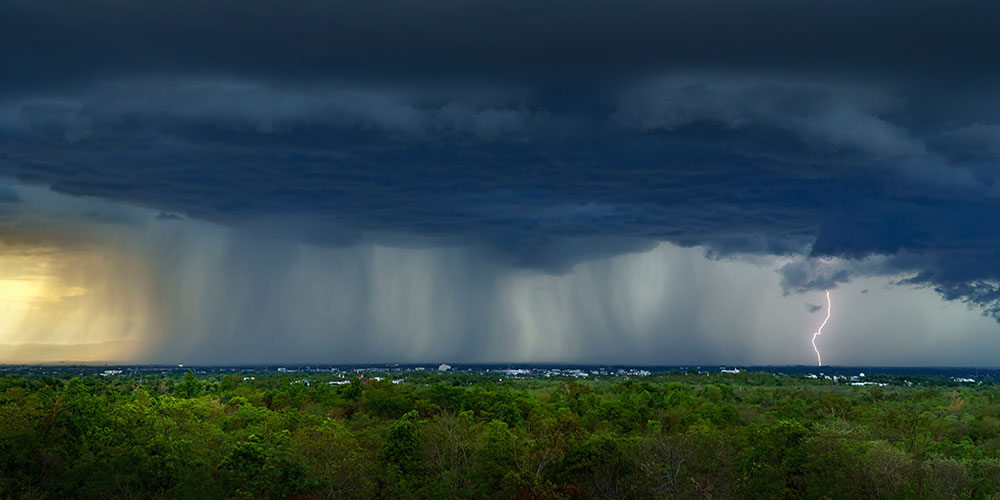The 2024-2025 academic year is underway. If there’s one thing campus IT admins should study up on this back-to-school season, it’s the impact extreme weather events can have on critical IT infrastructure.
In addition to extreme summer heat, this year’s hurricane season started on a historic note with Hurricane Beryl, the earliest category 5 hurricane ever recorded. More recently, Tropical Storm Debby wreaked havoc up and down the East Coast, leaving hundreds of thousands of outages in its wake.
For campus IT admins, ensuring uninterrupted IT operation is critical for both on-campus systems and online learning platforms. Campuses continually rely on critical power and any disruption caused by severe weather can threaten both everyday academic operations and safety. During this period of increased weather-related events, implementing a robust backup power strategy is essential to minimize downtime and protect the learning environment.
RELATED: School Storm Shelters: Understanding Requirements and Standards
3 Components of a Robust Backup Power Strategy
The increasing embrace of digitalization – to say nothing of the growing promise of AI – has transformed the higher education landscape and, as such, must be a preeminent consideration in schools’ disaster avoidance strategies. Technology infrastructure underpins both physical and online learning environments and is essential to advancing the student experience inside and outside the classroom. Consequently, campus IT admins are under substantial pressure to maintain and support these systems, ensuring their continuous operation even during the most severe weather events.
——Article Continues Below——
Advancements in power management technology have thankfully kept pace with the growth of digitalization, enabling campus IT admins to deliver greater resiliency of IT infrastructure. Because of this, implementing a comprehensive backup power strategy can help safeguard school IT systems, laboratories, building management, and security controls against severe weather and other unexpected events, especially in distributed campus environments.
At a minimum, a robust strategy should include the following components:
- Integrated backup power: Uninterruptible power supplies (UPS) are vital for disaster preparedness in school IT operations, acting as the critical link to long-term generator power during outages. Schools can now benefit from UPSs equipped with lithium-ion batteries, which are becoming more affordable and accessible, offering longer battery life and a more compact design. Furthermore, investing in UPSs that allow for integrated network cards allows for remote management and enhances cybersecurity, especially when integrated with emerging digital tools.
- Distributed management: Whether in a single location or across a distributed campus, schools may not always have IT staff available to address outage-related issues immediately. This underscores the importance of distributed IT performance management software for schools to maintain oversight of their power systems. Campus IT administrators can integrate software applications with their power management equipment to enable proactive remote management. These software tools allow for the remote shutdown or reboot of a “hung” server or other equipment during power outages caused by extreme heat, storms, or cyberattacks.
- Proactive monitoring: With the advancement of remote monitoring services, campus IT teams and facilities managers can now continuously observe and analyze power trends and adapt their power protection strategies that meet the unique needs of their educational institution. This ability allows admins to make well-informed decisions about their equipment, enabling proactive measures to repair or replace devices before downtime can cause any disruptions.
RELATED: How Colleges Can Better Prepare Students, Staff for Disaster Communication
Reliable hardware components like surge protectors and power strips are also vital for a thorough disaster preparedness plan, especially during extreme weather events. Integrating power management solutions with wall-mounted rack enclosures can also save floor space, prevent unauthorized access, and simplify future hardware upgrades, making them more efficient and manageable.
Fueling Educational Success
If Hurricane Beryl, Tropical Storm Debby, and future storms are an indication, campuses may face significant power-related challenges into the fall. Campus IT admins should take proactive measures now to avoid being caught off guard by severe weather events.
By developing a strategic backup power plan that includes the latest hardware and software innovations, schools can better protect essential IT systems and data from potential threats and ensure they can continue to deliver educational services to the highest standard.
Ed Spears is a technical marketing manager in Eaton’s Critical Power Systems division in Raleigh, North Carolina. A 40-year veteran of the power-systems industry, Ed has experience in UPS systems testing, sales, applications engineering and training—as well as working in power-quality engineering and marketing for telecommunications, data centers, cable television and broadband public networks.
NOTE: The views expressed by guest bloggers and contributors are those of the authors and do not necessarily represent the views of, and should not be attributed to Campus Safety.

